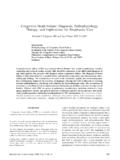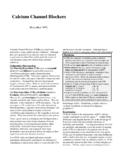Transcription of DATA SHEET NITROLINGUAL PUMPSPRAY - …
1 1 | Page New Zealand Data SHEET 1. PRODUCT NAME NITROLINGUAL PUMPSPRAY mg 2. QUALITATIVE AND QUANTITATIVE COMPOSITION Each metered dose (one puff) contains mg glyceryl trinitrate. For the full list of excipients, see Section 3. PHARMACEUTICAL FORM Oral spray 4. CLINICAL PARTICULARS Therapeutic indications Adults Treatment of acute angina pectoris. As well as relieving the pain of an acute attack, NITROLINGUAL PUMPSPRAY may be used prophylactically five to ten minutes prior to engaging in activities which may precipitate an acute attack. Dose and method of administration Dose Adults At the onset of an attack, initially one spray (400 microgram) should be sprayed under the tongue, followed by a second spray if pain relief has not occurred within 5 minutes.
2 No more than two metered doses are recommended. If chest pain persists, seek prompt medical attention. Elderly population Hypotension and syncope can be a problem with use of nitrates in the elderly. Dose adjustment is not necessary. Paediatric population No data are available on the use of glyceryl trinitrate in children. 2 | Page Method of Administration During application the patient should rest in the sitting position. The bottle should be kept vertical with the nozzle head uppermost. Hold the opening in the nozzle head as close to the open mouth as possible. Close the mouth immediately after each dose.
3 There is no need to shake the canister. Spray under the tongue or onto the oral mucosa. Patients should be instructed to familiarise themselves with the position of the spray opening for ease of use at night. The spray should not be inhaled. Contraindications Known sensitivity to glyceryl trinitrate or idiosyncratic reaction to organic nitrates. Known sensitivity to any excipients (see Section ). Acute circulatory failure (shock, circulatory collapse). Uncorrected hypovolaemia. Pronounced hypotension (systolic blood pressure below 90 mmHg). Increased intracranial pressure (eg.)
4 Head trauma or cerebral haemorrhage). Severe anaemia or arterial hypoxaemia (see Section ). Constrictive pericarditis and pericardial tamponade. Cardiogenic shock. Concomitant administration of certain medicines (phosphodiesterase inhibitors, soluble guanylate cyclase stimulators) for the treatment of erectile dysfunction or pulmonary arterial hypertension and NITROLINGUAL is contraindicated due to an increase in the hypotensive effect of NITROLINGUAL . This may result in severe side effects such as syncope or myocardial infarction. Special warnings and precautions for use The use of any form of glyceryl trinitrate during the early days of acute myocardial infarction requires particular attention to haemodynamic monitoring and clinical status.
5 Especially careful monitoring by a doctor is necessary in: patients with constrictive pericarditis, pericardial tamponade, acute myocardial infarction with low filling pressure, a reduction of the systolic blood pressure below 90 mmHg should be avoided, aortic and/or severe mitral stenosis, tendency to orthostatic disturbances of circulatory regulation, patients with cerebrovascular disease since symptoms may be precipitated by hypotension, patients with incipient glaucoma should be avoided. Because NITROLINGUAL PUMPSPRAY is more stable than glyceryl trinitrate tablets, it is possible that some patients transferred to the spray will receive a larger dose of the drug than usual.
6 This may increase possible side effects, headache (see Section ). 3 | Page General Severe hypotension, particularly with upright posture, may occur even with small doses of glyceryl trinitrate. Paradoxical bradycardia and increased angina pectoris may accompany glyceryl trinitrate induced hypotension. The use of glyceryl trinitrate could theoretically compromise myocardial blood supply in patients with left ventricular hypertrophy associated with aortic stenosis because of the detrimental effects of tachycardia and decreased aortic diastolic pressure. Detailed haemodynamic studies in a small number of patients with valvular aortic stenosis with and without concomitant significant coronary artery disease studied in the supine position have not shown adverse effects with sublingual glyceryl trinitrate.
7 However, it seems prudent to be cautious in treating ambulant patients with the combination of angina and moderate to severe valvular aortic stenosis. NITROLINGUAL PUMPSPRAY contains small amounts of ethanol (alcohol), less than 10 mg per spray dose. Tolerance Tolerance to this drug and cross tolerance to other nitrates and nitrites may occur. Tolerance to the vascular and antianginal effects of nitrates has been demonstrated in clinical trials, experience through occupational exposure, and in isolated tissue experiments in the laboratory. Intermittent therapy, such as with NITROLINGUAL PUMPSPRAY , will reduce the likelihood of tolerance developing to glyceryl trinitrate.
8 Withdrawal Various clinical trials in angina patients indicate that withdrawal of glyceryl trinitrate may cause rebound of haemodynamic effect and a more ready provocation of anginal attack. Hypoxaemia Arterial oxygen tension decreases after administration of glyceryl trinitrate in normal subjects and in patients with coronary artery disease. Caution should be observed in patients with severe ischaemic heart disease as a decrease in available oxygen may oppose its antianginal effect. Methaemoglobinaemia Methaemoglobinaemia has been reported in association with high doses of glyceryl trinitrate therapy.
9 This may be clinically significant, especially in the presence of methaemoglobin reductase deficiencies or in congenital methaemoglobin variants. Paediatric population The safety and effectiveness of glyceryl trinitrate in children have not been established. 4 | Page Interaction with other medicines and other forms of interaction Concomitant intake of other vasodilatators, other antihypertensives ( -blockers, calcium antagonists, ACE inhibitors, diuretics), neuroleptics or tricyclic antidepressants, alcohol and sapropterin may potentiate the antihypertensive effect of NITROLINGUAL PUMPSPRAY .
10 N-acetylcysteine may potentiate the vasodilator effects of glyceryl trinitrate. Concomitant use of NITROLINGUAL and certain medicines (phosphodiesterase inhibitors, soluble guanylate cyclase stimulators) for the treatment of erectile dysfunction or pulmonary arterial hypertension enhances the hypotensive effect. Therefore, the concomitant administration of NITROLINGUAL and these medicines is contraindicated (see Section ). If a patient treated with these medicines for erectile dysfunction or pulmonary arterial hypertension needs a rapidly effective nitrate ( in the case of an acute angina pectoris attack) he/she must be closely monitored.












